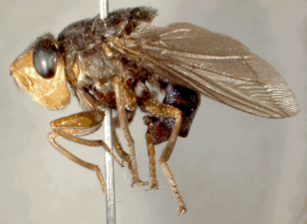
Flies are insects of the order Diptera, the name being derived from the Greek δι- di- "two", and πτερόν pteron "wing". Insects of this order use only a single pair of wings to fly, the hindwings having evolved into advanced mechanosensory organs known as halteres, which act as high-speed sensors of rotational movement and allow dipterans to perform advanced aerobatics. Diptera is a large order containing more than 150,000 species including horse-flies, crane flies, hoverflies, mosquitoes and others.

Botflies, also known as warble flies, heel flies, and gadflies, are flies of the family Oestridae. Their larvae are internal parasites of mammals, some species growing in the host's flesh and others within the gut. Dermatobia hominis is the only species of botfly known to parasitize humans routinely, though other species of flies cause myiasis in humans.

Myiasis, also known as flystrike or fly strike, is the parasitic infestation of the body of a live animal by fly larvae (maggots) that grow inside the host while feeding on its tissue. Although flies are most commonly attracted to open wounds and urine- or feces-soaked fur, some species can create an infestation even on unbroken skin. Non-myiatic flies can be responsible for accidental myiasis.

The eastern chipmunk is a chipmunk species found in eastern North America. It is the only living member of the genus Tamias.

The human botfly, Dermatobia hominis, is a species of botfly whose larvae parasitise humans. It is also known as the torsalo or American warble fly, though the warble fly is in the genus Hypoderma and not Dermatobia, and is a parasite on cattle and deer instead of humans.

Muscina is a genus of flies that belongs to the family Muscidae, currently consisting of 27 species. They are worldwide in distribution and are frequently found in livestock facilities and outside restrooms. The most common species are M. stabulans, M. levida, and M. prolapsa. Muscina flies commonly breed in manure and defecate on food, which has been linked to the spread of some disease and illnesses. The occurrence of Muscina larvae on dead bodies has led to their regular use in forensic investigations, as they may be used to estimate the time of death. Research have shown the prevalence of certain species of Muscina flies as vectors of diseases such as poliomyelitis.

Cuterebra, or rodent bots, is a genus of bot flies that attack rodents and similar animals.
Cuterebra austeni is a species of new world skin bot flies in the family Oestridae.

Cuterebra fontinella, the mouse bot fly, is a species of New World skin bot fly in the family Oestridae. C. fontinella is typically around 1 cm (0.39 in) in length with a black and yellow color pattern. C. fontinella develops by parasitizing nutrients from its host, typically the white-footed mouse. C. fontinella has even been known to parasitize humans in rare cases. Individuals parasitized by C. fontinella will develop a large bump on the skin that is indicative of parasitization.
Cuterebra approximata is a species of new world skin bot fly in the family Oestridae. The larvae are typically parasites of Peromyscus maniculatus. Larvae typically go through three instars before emerging from the host to pupate in the morning. Adult flies also emerge from pupation in the morning.
Cuterebra atrox is a species of new world skin bot fly in the family Oestridae.
Cuterebra bajensis is a species of new world skin bot flies in the family Oestridae.
Cuterebra arizonae is a species of new world skin bot fly in the family Oestridae.

Cuterebra cuniculi is a species of new world skin bot fly in the family Oestridae. Its range is restricted to the states of Georgia and Florida. Its larvae are parasites of the eastern cottontail and marsh rabbit.
Cuterebra jellisoni is a species of new world skin bot fly in the family Oestridae.
Cuterebra tenebrosa, the rodent bot fly, is a species of new world skin bot fly in the family Oestridae.
Cuterebra buccata, the rabbit bot fly, is a species of new world skin bot fly in the family Oestridae.
Cuterebra lepivora is a species of new world skin bot fly in the family Oestridae. Its larvae are usually parasites of cottontail rabbits. Adult males can be territorial.
Cuterebra americana, the woodrat bot fly, is a species of new world skin bot fly in the family Oestridae.
Cuterebra polita is a species of new world skin bot fly in the family Oestridae.








